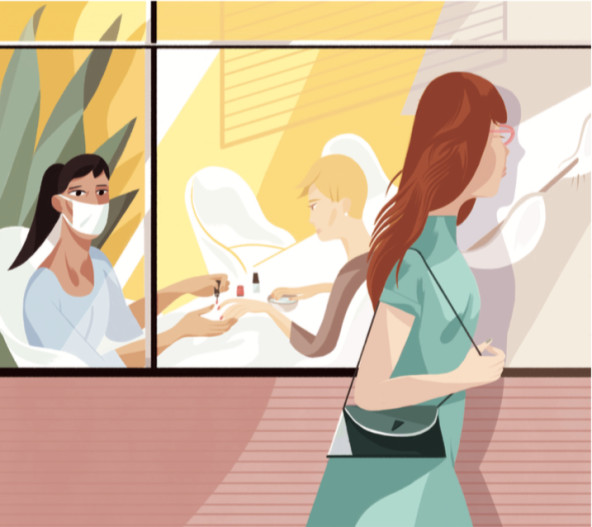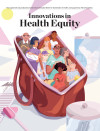
When Narbada Chhetri moved to New York City, she labored as a domestic worker during the week and worked at a nail salon on the weekends. At first she was happy interacting with other workers at the salon, but the low pay was not enough to sustain her. She found another nail salon where the pay was slightly better, but there she didn’t have set breaks, and when she did take time to rest—to eat, or to get some distance from the polish fumes, which bothered her eyes—she was continually interrupted by an abusive employer who demanded that she return immediately to tending to customers. Her co-workers were treated the same way, even one who suffered from backaches. When the employer refused to provide employees with toilet paper and asked them to bring their own, that was the last straw.
Innovations in Health Equity

This special supplement examines the organizations and programs that are addressing social inequalities in housing, transportation, work, and other parts of society that create disparate health outcomes.
-
Innovations in Health Equity and Health Philanthropy
-
Illuminating the Health Equity Challenge
-
Partnering with Philanthropy in Native America
-
Building Power, Building Health
-
Philanthropy on the Frontlines of Ferguson
-
Promoting Health Impact Assessments
-
Building a Healthier Nail Salon Industry
-
Embracing Healing Justice in California
-
Ending LGBT Health Inequities
-
Achieving Healthy Communities Through Transit Equity
-
Using Fair Housing to Achieve Health Equity
-
Reducing Health Disparities in Atlanta
Having worked for a human rights organization in Nepal, Chhetri knew that her employer was exploiting her and the other workers. She started laying the groundwork to create a community organization to support other Nepali and Tibetan workers who were doing domestic or nail salon work.
Then, in 2005, she co-founded Adhikaar—which means “rights” in Nepali —to advocate for the rights of recently arrived Nepali immigrants, as well as Nepali-speaking immigrants and refugees from Tibet and other countries. Adhikaar opened a formal community center in 2007, and Chhetri continues to play a crucial role; today she is the center’s director of organizing and advocacy.
Making Nail Salons a Health Equity Issue
The nail salon business is flourishing in the United States. Approximately 375,000 technicians spend long hours buffing, scraping, painting, and polishing Americans’ nails. According to NAILS magazine, consumers spent $8.4 billion on their nails in 2014.1 But the nail salon worker population in New York City, comprising mostly Asian and Latina immigrant women, toils in an industry that has often operated under the radar of labor laws and regulations. Employers often take advantage of recently arrived and undocumented immigrant women, many of whom speak little English and have varied literacy skills.
Too often, nail salon workers are underpaid, undervalued, exposed to dangerous chemicals, overworked, and abused. Hired at a daily rate as low as $35, many depend on tips for their livelihood. They work long hours in the summer and many fewer hours in the winter, when they lose steady income. They often work with no lunch or bathroom break. Many nail salon workers are also intentionally misclassified as “independent contractors” in an effort to deny them basic employee benefits such as Social Security, worker’s compensation, paid vacation, and sick time.
The health consequences of these jobs are impossible to ignore. Workers have reported skin and respiratory irritations, difficulty breathing, headaches, and trouble concentrating.2 There are an estimated 10,000 chemicals found in nail products, and 89 percent of those have not been tested by an independent agency for safety.3 Most nail products, in fact—including nail polish, solvents, acrylics, and gels—contain harmful chemicals such as formaldehyde, toluene, dibutyl phthalate (the “toxic trio”), and methacrylates. Regular exposure to these chemicals is associated with asthma, cancer, neurological disorders, and reproductive harm.4
Nail salon workers have also reported a high prevalence of work-related musculoskeletal issues; neck, lower back, hand, wrist, and shoulder injuries are common.5 Exposure to biological hazards such as fungi, bacteria, and viruses, including bloodborne pathogens such as hepatitis B, is also a concern.6
Unsurprisingly, because nail salon workers are often undocumented and uninsured, they face significant challenges in accessing health-care services. Many fall through the safety net. If they suffer from a chronic condition that requires regular medical attention, they must endure long waits at clinics, and then many times find themselves trying to communicate with a doctor who doesn’t speak their language.7 Although most nail salon workers know that their jobs may be responsible for their ill health, their options for changing careers are limited.
Building the Coalition
Nail workers’ conditions are deplorable. But Adhikaar’s work is making a difference, as are the organization’s partnership with the New York Committee for Occupational Safety & Health (NYCOSH) and the subsequent creation of the New York Healthy Nail Salons Coalition. NYCOSH first started working to improve nail salon working conditions in 2004 by conducting a health and safety survey of 100 Korean nail salon workers. Then Adhikaar held a gathering for nail salon workers, where they were encouraged to identify campaign priorities related to health and safety. In 2012, Adhikaar and NYCOSH hosted a forum to highlight exploitative conditions of immigrant women in the beauty services industry and strategize about how to work together.
In 2014, NYCOSH partnered with Adhikaar to launch a campaign to transform health and labor conditions within nail salons. By expanding the definition of health to include workers’ rights and living wages, the two organizations attracted the interest of other organizations and agencies, and New York Healthy Nail Salons Coalition was born. The coalition quickly began to push for policy change, first in New York City and then in New York State. Coalition partners were initially funded by foundations like Mertz Gilmore and the North Star Fund in New York City.
The coalition has made tangible progress: NYCOSH and Adhikaar partnered with the New York City Public Advocate on an industry-wide report that resulted in an increase in NY Department of State inspectors. More recently, the coalition introduced a package of nail salon reforms to the New York City Council. The council was responsive, and on May 10, 2015, shortly after the city introduced the new legislation, the New York Times published a widely publicized exposé on the industry that garnered the attention of New York Governor Andrew Cuomo and the entire nation.
Governor Cuomo quickly introduced emergency regulations and began strategizing with the coalition about new legislation to establish permanent statewide nail salon regulations. New regulations, developed as a result, include the mandatory posting of a Nail Salon Workers’ Bill of Rights in all salons, featuring information about the legal wage, health and safety protections such as mandatory goggles and respirators, and a hotline for workers to call in case of violations. New regulations also require that the licensing exam be translated into several other languages, including Nepali, Tibetan, and Vietnamese.
The summer of 2015 saw another promising initiative launch: the Nail Salon Worker Organizing Project, organized by NYCOSH, Adhikaar, and Workers’ United. The project seeks to support workers with trainee and licensing application support, Know Your Rights training, and training on health and safety in the workplace. Within one month, hundreds of workers had come to these organizations, eager to understand how the media attention and the governor’s new legislation would affect their lives.
Since the new regulations were announced, workers have encountered retaliation from some employers: firings, reduced hours, bullying, and threats. But as they discover their rights and public support, workers are showing great courage and leadership—standing up, reporting abuse, and becoming their own best advocates. They are also increasingly realizing that they are not alone in facing down unfair practices, and that they have allies in many of their customers. After the New York Times exposé, thousands of consumers came out in support of nail salon workers.
NYCOSH has also begun crafting a plan for a Healthy Salons Program that would get salons to agree to a set of standards, including living wages, health and safety protections, and a commitment to training workers and monitoring worker conditions. Through those standards, we plan to develop a list of model salons that can be promoted to socially conscious consumers. In addition, we plan to work on citywide policy campaigns that institutionalize the training and education of business owners and the implementation of a letter-grading system. We will move at the state level to eliminate toxic products and encourage the use of safer alternatives.
Ultimately, improving the health of nail salon workers will require collaboration with a diverse set of partners. Health funders, in particular, have a transformative role to play to support us as we seek to create healthy nail salons in New York and across the country, conduct medical monitoring and research on the short- and long-term health impacts of working in nail salons, and improve workers’ access to health care. We are calling for new collaborators as we seek to transform the nail salon industry—and the lives of workers, consumers, businesses, and the environment in the process. We believe that our model of worker-influenced campaigns to create healthy nail salons can be replicated in other cities and states, and we’re working toward that end.
Support SSIR’s coverage of cross-sector solutions to global challenges.
Help us further the reach of innovative ideas. Donate today.
Read more stories by Susan McQuade, Mónica Novoa & Charlene Obernauer.

